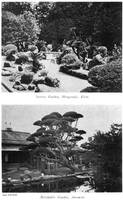This Plate has been introduced to show different treatments of vegetation in Japanese gardens. The upper illustration is taken from the garden of the Eastern Hongwanji, a Monastery in Kioto, which is planted with dwarf palms of the Cycas revoluta species, called by the Japanese Sotetsu. These, together with junipers, azaleas, and other clipped bushes, and fine rocks and boulders, are grouped on either side of a sunken sanded channel constructed to represent a river bed. In one place this bed is crossed by a granite bridge consisting of a single slab. A background is formed of thickly planted trees and rocks, from behind which the imaginary stream appears to issue. This garden is a fine example of the Kare Sansui, or "Dried-up Water Scenery," frequently introduced into Japanese gardens, and described at length in "Landscape Gardening in Japan." The lower illustration represents the garden of a merchant at Awomori, and displays a fine example of a Japanese pine-tree of magnificent size, trimmed in the tama-tsukuri style. The garden is simple in character, having a small lake edged with rocks, bushes, and water-plants; rows of stepping stones lead from the residence, and a few lanterns and interesting rocks are introduced.

